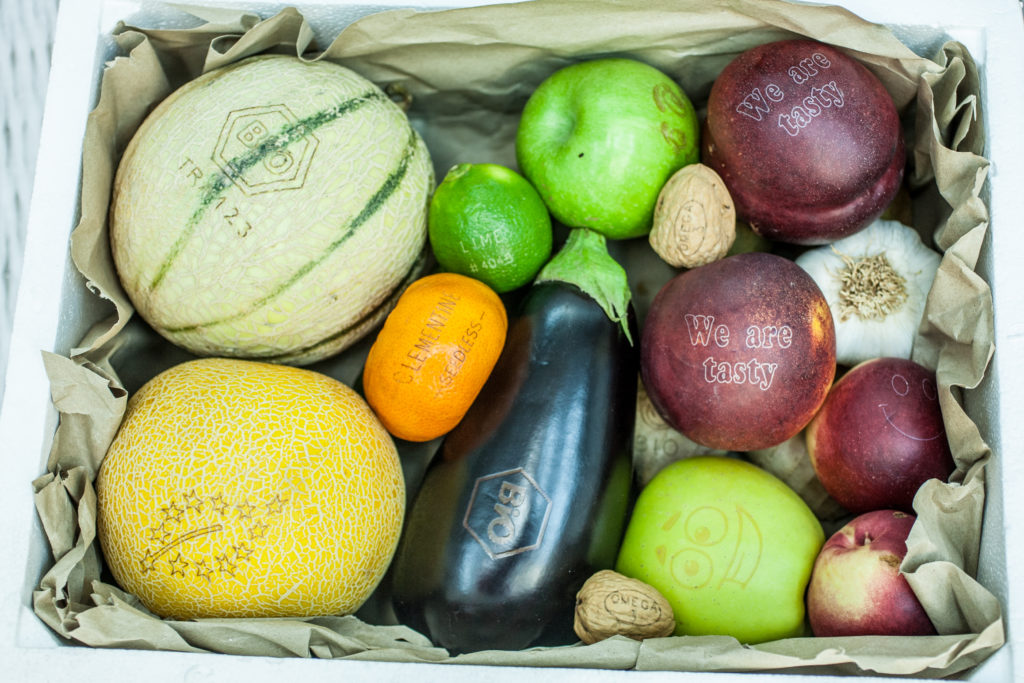
Natural Branding by Laser Food is a contactless, safe method of labeling without packaging. A high definition laser removes pigments from the outer layer of fruit or vegetable skin to create an image on the peel. The process is superficial so it does not have a negative effect on the taste, aroma or shelf-life of the product. Consumers can even eat the marked produce peel! To see how natural branding is done, take a look at the video here.
Just several months ago, one of the leading fresh produce companies in Europe, Eosta / Nature & More announced that they will mark organic fruits and vegetables with Natural Branding, to lessen plastic packaging. The project will be done in close cooperation with the Swedish supermarket chain ICA. The first organic products to be sold with Natural Branding are avocados and sweet potatoes.
The Advantages of Natural Branding by Laser Food
Ever since the announcement in December 2016, this news resonated in the produce industry. According to Eosta/Nature & More, some of the advantages of using this technique are:
- Labels will stay on the product
- Eliminating adhesives, inks, etc.
- Improve marking and tracking of individual produce
- Reducing in energy use and gas emissions (the energy needed for marking is less than 1% of the energy needed for making a sticker)
- Reducing the amount of plastic waste
For avocados alone, Eosta/Nature & More are expecting to eliminate 750,000 plastic units in 2017. And with more products and customers, the number can easily reach millions!
What Do the Front-Runners Say
TYKMA Electrox reached out to Eosta’s Sustainability & Communications Manager, Michaël Wilde, and this is what he said regarding the reasons behind the switch to Natural Branding:
“We have been following the developments regarding laser technology for more than 8 years (branding premium watermelons for Carrefour for example) and were aware of the potential for saving plastic for organic produce. In the past year, in close cooperation with the producer of the machine Laser Food and the University of Valencia, we brought the technology to the next level which now enables us to use the technique for a wide range of products without affecting shelf life, taste, etc.”
In addition to that, Wilde says that after the initial investment in the laser machine, it is almost more cost-effective than stickers. “You have to invest in an extremely expensive machine, so it’s very much an investment for the future. This is something we believe more and more supermarkets will take on. It saves resources, CO2 and energy, so it does calculate.”
Laser Food, the Spanish company behind the technology, used it for several years for marketing or branding, but up until now it wasn’t used with the specific aim of eliminating packaging. “It was used for novelty – which is nice, but a gimmick at Easter or Christmas isn’t going to pay off,” says Wilde, “What we are saying is, by buying this product you’re saving plastic.”
Paul Hendriks, packaging expert at Nature & More, is also very pleased with the new technology. “The most sustainable way to pack is not to pack. I have been saying that for years, but it has been difficult to bring about in the supermarket. With Natural Branding, it becomes a logical option. We are very glad that ICA, as a front-runner, is taking this sustainable road with us. We think green consumers will be delighted, because research shows again and again that they disapprove of plastic packaging.”
What About the Future?
According to the Guardian, ICA is already preparing to expand this technology to other products as well, the next steps being products such as nectarines or apples. Especially of interest are products where there is already a challenge with stickers not adhering to the product very well, like melons for example.
Other supermarket chains seem to be following this trend as well. For example, a year ago, UK supermarket M&S trialed this technology on oranges; however, as citrus skin has the ability to “heal” itself, the technique was not as effective and the trial was suspended. However, the retailer then started using it on coconuts, and now has plans to expand to other products as well.
This laser technology was originally used on bio/organic products to easily differentiate them from ‘standard’ produce. However, as consumer awareness and interaction becomes more important, this labeling technique has the potential to expand further, to all fruits and vegetables that don’t require grouping. What an impact that would be!
Image courtesy of Laser Food
